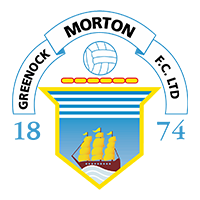The 19th Century
• 1874
Morton Football Club was established in Greenock; Games were initially played at Grant Street (1874), Garvel Park (1875), Cappielow (1879-81), Ladyburn (1882) returning to Cappielow in 1882 – the club has played there ever since (142 years).
• 1877
First Senior game v Barrhead Rangers (away) in Scottish Cup Round 1 on 29th September, results in a 7-0 defeat.
• 1879
First Senior victory, recovering from a 4-0 deficit, Morton defeated Netherlee 7-4 in the Scottish Cup Round 1 at Cappielow on 27th September, with captain James Gillespie, scoring Morton’s first senior hat-trick.
• 1880s
The Greenock & District Cup is won by Morton in 1881/82 and 1882/83; and the Greenock & District Charity Cup 6 times in its 10-year history, including successive wins in the first three years of the competition between 1884/85 and 1886/87.
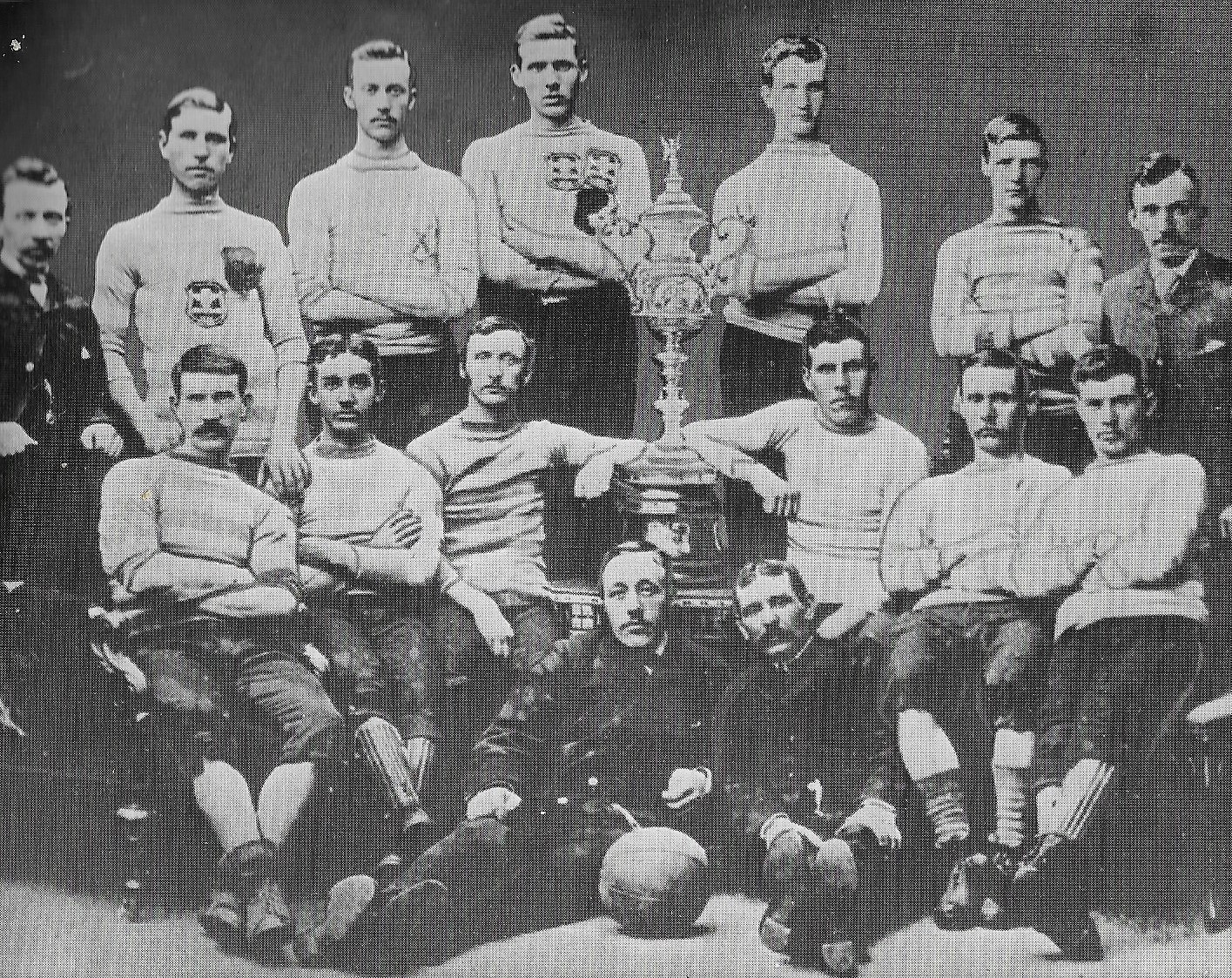
Morton 1884/85 with Charity Cup
• 1886
Robert Fleming becomes Morton’s first Scottish international, capped v Ireland on 20th March. On 10th November, Morton’s biggest senior victory was recorded, an 11-0 win v Carfin Shamrock in the Scottish Cup, a record which stands to this day.
• 1893
Morton recorded the first of 51 Renfrewshire Cup wins beating St Mirren 3-0 in Paisley. The Club turns professional in September and is one of 11 clubs to join the new Scottish Football League Division 2 for Season 1893/94.
• 1896
Goalkeeper Robert MacFarlane is capped for Scotland v Wales on 21st March. On 30th July, Morton forms a limited company – “The Greenock Morton Football & Athletic Club Ltd”- the first football club to do so.
• 1897
Morton lose their first Scottish Cup semi-final 7-2 to Rangers at Cappielow watched by 12,000.
• 1898
Half-back Peter Campbell is capped for Scotland v Wales on 19th March
The 20th Century 1900-1918
• 1900
Morton finished second in Division 2 and were elected to Division 1; they subsequently avoided relegation on several occasions due to league expansion, and the 27-year stay in the top-flight remains the longest in the Club’s history.
• 1908
Robert Cochran becomes the club’s second, and most successful manager.
• 1910 – 1913
On 22nd November 1910, Morton record a famous 5-1 victory over Rangers at Ibrox. In 1912 full back, Robert Stewart leaves the club after a record 271 appearances. Full back “Tanny” Craig is capped for Ireland in March 1912.
In subsequent few years, key players such as Jackie Wright, Jimmy Gourlay and Stan Seymour join the club.
• 1914 -1919
Morton finish in the top four of Division 1 for six consecutive seasons, with a best finish of 2nd place in 1916/17 season. The Club win the 1914/15 War Shield competition, beating Rangers in the Final, but lose to Celtic in the 1917/18 Final. Keeper James Brownlie, half-back Jackie Wright, and forward Jimmy Gourlay win full international or League Caps during this period.
The 20th Century 1919-1939
• 1920-1921
Centre Forward George French scores 37 goals in his debut season of 1919/20. Both he and full back Jock McIntyre win League caps, whilst right winger Alex McNab wins 2 full caps for Scotland. Morton lose 3-2 to eventual winners Kilmarnock in an SFA Cup semi-final in 1920 after leading 2-0.
• 1922
On April 15th, Morton defeat Rangers 1-0 in the Scottish Cup Final at Hampden, watched by 73,861 spectators. Jimmy Gourlay scores the only goal direct from a free-kick. George French misses the Final but his 37 goals over the season take his total to 99 in 120 appearances. Cappielow attracts a record 23,500 crowd for the final game of the season v Celtic, the game finishing 1-1 to confirm the Glasgow club as Champions, but this being overshadowed by riots inside and outside the stadium.
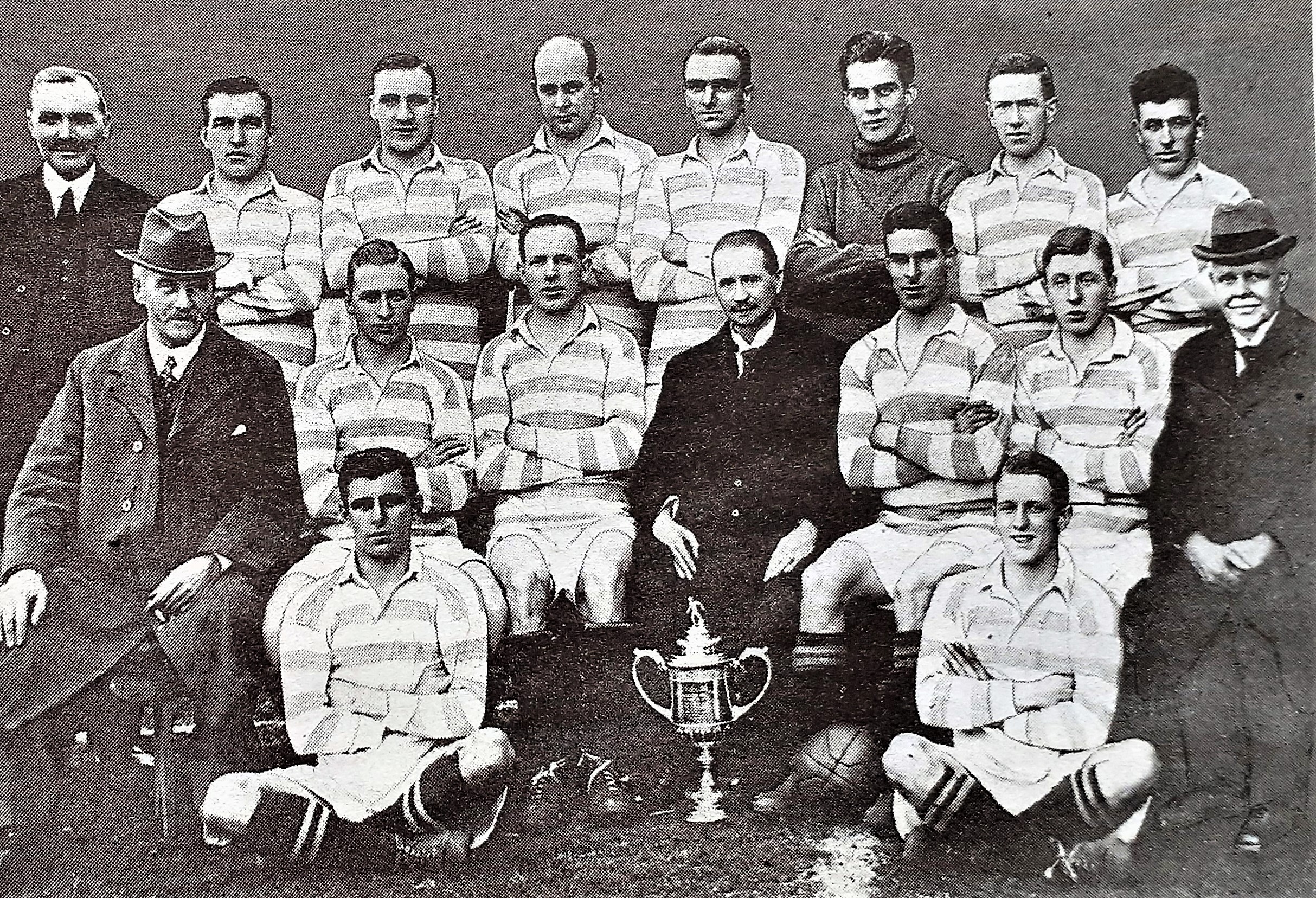
Morton Win 1922 Cup Final
• 1923 -1927
With the break-up of the 1922 side, Morton are relegated for the first time; McIntyre, and McNab have already retired or moved on with over 300 appearances each, Wright and Gourlay with over 400 appearances, and French leaves having scored 132 goals in 200 appearances becoming the club’s top scorer until overtaken by Allan McGraw 40 years later. Manager Cochran also resigns.
• 1928 – 1929
The club slump to 18th in Division 2 in 1927/28, before promotion in second place in 1929 under new manager David Torrance.
• 1930 – 1933
Winger Dan McRorie is capped for Scotland in 1930 shortly before his transfer to Liverpool. The current Cappielow Grandstand is opened in October 1931. Robert Cochran returns for a second spell as manager in 1931.Centre Forward Dick Black scores 38 goals in 1931/32 and is transferred to Manchester United.
• 1934 – 1939
Relegation in 1933 leads to Cochran’s resignation and Jackie Wright is appointed manager in 1934. Striker Jock Calder scores 106 goals in 73 games over the next two seasons, including a Club Record 55 League goals (59 in total) in 1935/36 season, as Morton go on to win promotion in 1936/37. He scores a Club and Second Division record 8 goals in an 11-2 victory over Raith Rovers in April 1936 but is transferred to Bolton Wanderers before promotion is achieved and misses an SFA Cup semi final v Aberdeen in 1937, Morton losing 2-0.
• Promotion in 1937 is followed by relegation in 1938, with Wright resigning as Manager and being replaced by Jimmy Davies.
The 20th Century 1939-1964
• 1939 – 1945
The outbreak of war sees all official tournaments cancelled, with unofficial Leagues and Cups introduced. Davies rebuilds Morton, signing future internationals Jimmy Cowan, Billy Steel, Billy Campbell, Johnny Kelly and Tommy Orr. Former striker Jock Calder also returns for 2 seasons with the consent of his club, netting a further 60 unofficial Morton goals, on top of the 106 official strikes in the 1930s.
• Morton lose 1-0 in the Final of the Southern League Cup to Rangers in March 1942, and finish 2nd in the Southern League in 1943. There are cameo appearances for Morton from English stars Stanley Matthews (7 games) and Tommy Lawton (8 goals in 4 games)
• 1947 -1948
Whilst official competitions restart in 1946/47, several Morton stars do not return from service immediately. Despite finishing the pre-war campaign in Division B, Morton restart in Division A . There are international caps for Campbell, Kelly & Steel but the latter two are transferred to England, Steel to Derby County for a world record fee of £15,500.
• With the return of Orr and Cowan in 1947/48, Morton make it to a second Scottish Cup Final, beating Celtic in the semi-final after extra time, watched by 81,000. The Final v Rangers finishes 1-1 after extra time, skipper Jimmy Whyte scoring from a free kick after 3 minutes; the replay goes to extra time too, Rangers scoring late on in fading light. 265,199 people attend the two games setting several records, with the 133,570 at the replay being the largest ever Morton crowd, and the largest ever British midweek attendance.
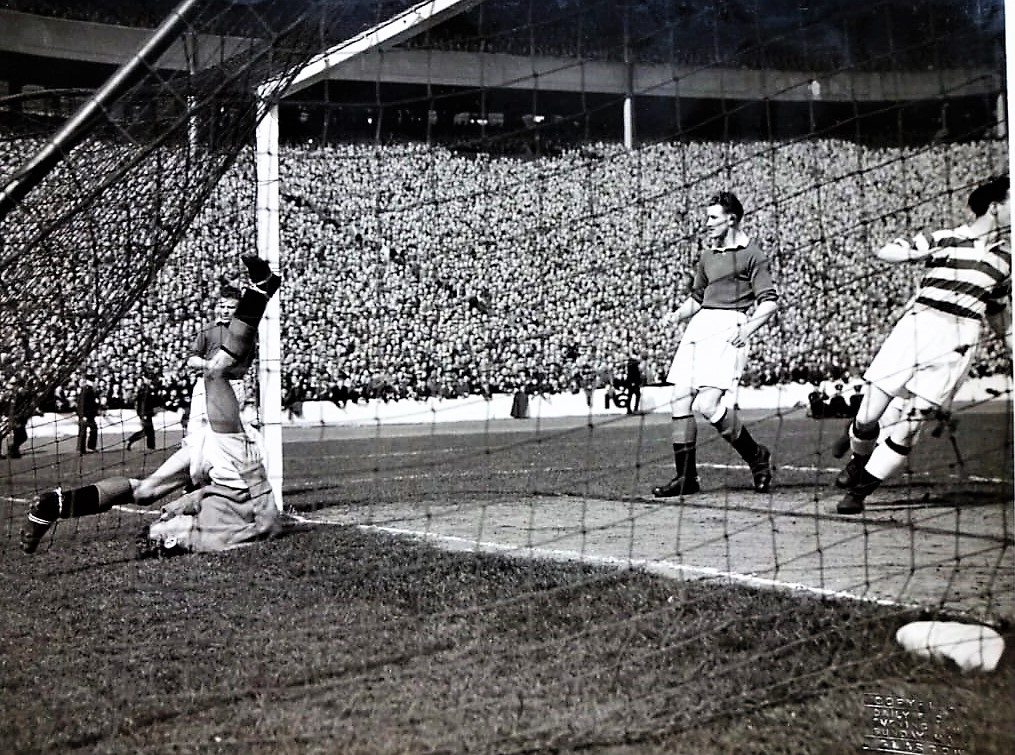
Morton score in the 1948 Cup Final
• Both keeper Cowan and right- half Campbell are selected for several Scotland games, Cowan winning the first of his 25 caps on 28th April 1948, just one week after the Cup Final replay.
• 1948-1949
This season sees Morton record attendance figures, with 296,505 fans attending “home games” – an average of 14,825. But the season is a disaster; Cappielow is unplayable and Morton are forced to play games in Ayr, Paisley or Glasgow. Billy Campbell contracts Tuberculosis and is forced to retire, and Jimmy Cowan’s Wembley heroics are forgotten as Morton are relegated just two weeks later, falling out of the 16-team league by the finest of margins. The 51,000 who watched Morton play Clyde in a “home” cup tie at Ibrox remains the record “home” Morton attendance.
• 1950 – 1961
The new decade starts well, with Morton winning the Second Division Championship in 1949/50 for the first time. Neil Mochan scores 34 goals as the club wins 20 of its 30 League matches, losing only 3. A year later, Mochan moves to Middlesborough for a £14,000 fee.
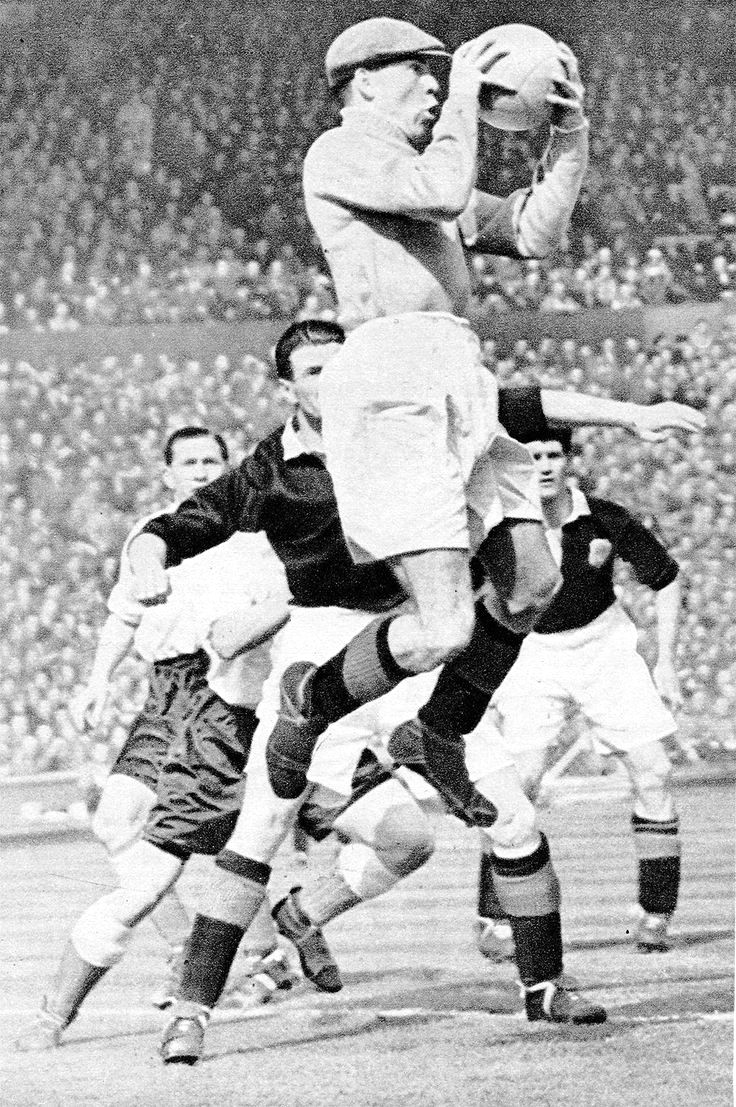
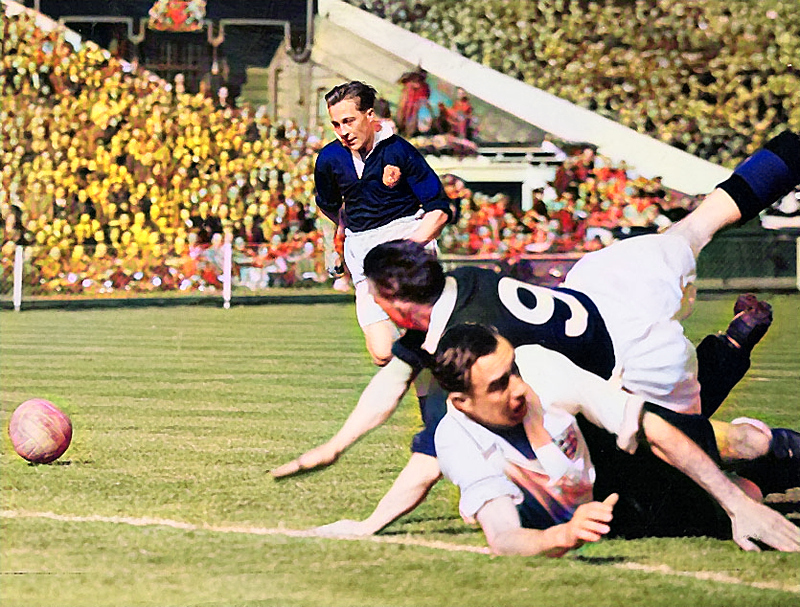
Jimmy Cowan (Top) & Billy Steel (Bottom) pictured against England in 1949
• Tommy Orr is capped twice for Scotland in 1951 and Cowan is a regular for the national side being awarded his 25th and final cap against Sweden in May 1952, shortly after Morton are relegated once more at the end of 1951/52 season. A 12-year exile in the lower division starts. Cowan moves to Sunderland in 1953 and manager Davies resigns in 1955.
• New Chairman John S Thomson invests in floodlights and the creation of the covered “Cowshed” in 1958, but crowds and League position fall in equal measure and by April 1961 Morton are officially the worst team in Scotland, finishing 19th in Division 2, with average crowds around 2,000.
• 1961-1963
The arrival of Director/Manager Hal Stewart in 1961 is the catalyst for a change in the Club’s fortunes. Ex-internationals Archie Robertson and Doug Cowie are signed, bringing influence and experience; so too is striker Allan McGraw from Army football and winger Jimmy Wilson from Newcastle. The team gradually brings the crowds back, average gates reaching 5-6,000 as Morton just miss out on promotion with two third place finishes in 1962 and 1963, McGraw nets 53 goals in 58 games in his first two seasons.
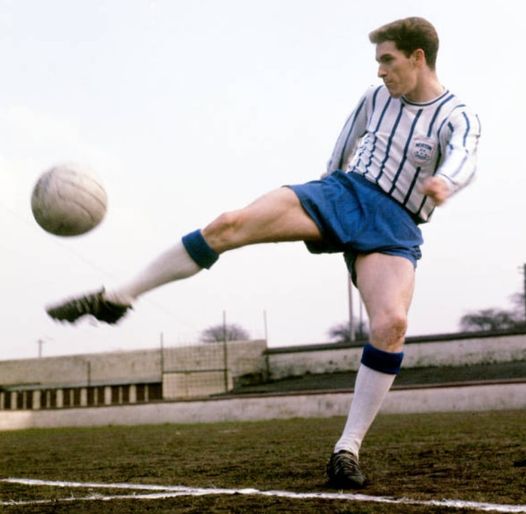
Allan McGraw
• 1963-1964
Undoubtedly one of the most exciting seasons in Morton’s history, as a new side mixing existing players with free transfer signings explodes into action. An unbeaten League Cup run takes the club to a Hampden final against Rangers, with Division One clubs Motherwell and Hibernian defeated en route. A record crowd of 105,907 sees Morton compete well for an hour, before capitulating to a 5-0 defeat.
• Morton have won their opening 10 League matches scoring 47 goals, and that run continues, 25 consecutive league victories (including the final two games of the previous season) setting a new British record, matched but never beaten. Only one league match is lost, Morton picking up a record 67 points out of a possible 72, scoring 171goals in all competitions with a goal difference of +115! Crowds at Cappielow average 9,500. Goal machine Allan McGraw nets 61 goals, 50 of those coming in the League campaign.
• There’s more excitement with the signing of three Danish internationals –Erik Sorensen, Kai Johansen and Carl Bertelsen – with 50 caps between them – in preparation for the return to Division One.
The 20th Century 1964-1975
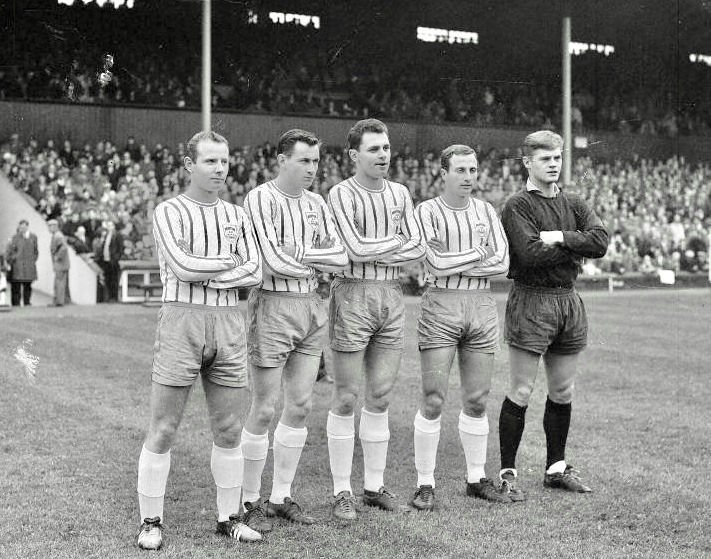
The Danish Invasion
• 1964-1966
Morton’s return to the top-flight starts well, with another League Cup run, ending with semi-final defeat to Celtic. There are further Danish signings including Jorn Sorensen from Metz and Flemming Nielsen from Atalanta, and average league crowds of almost 10,000 make Morton the sixth best supported club in the country. However, with the break-up of the 1963/64 team and the sale of Johansen, Bertelsen and Jorn Sorensen, results deteriorate and Morton are relegated in 1965/66 after just two years. Allan McGraw is transferred to Hibernian, but remains the club’s record scorer with 148 goals.
• 1966 – 1967
Morton immediately return to Division One in 1967 with a third Championship, breaking more records – 69 points, a goal difference of +93, and a record 24 clean sheets for keeper Sorensen. Joe Mason and Joe Harper form an exciting striking partnership; Mason scores 44 goals in his debut season, Harper 30 before his transfer to Huddersfield Town.
• 1967 – 1975
Morton remain in the First Division for 8 years until League reorganisation – it’s an eventful time, reaching League Cup and Scottish Cup semi-finals in 1967/68 , clinching a place in Europe against Chelsea, and another Cup semi-final in 1968/69. Joe Harper rejoins the club in 1968, and Scottish legend Bobby Collins joins the club in 1969; there’s a return for Danish keeper Sorensen in 1970. And Danish striker Per Bartram scores a 6 minute hat-trick inside the first 10 minutes at Parkhead in 1969 in a 4-2 Morton win.
• The Club celebrates its centenary in 1974; however, attendances have fallen and second bottom place at the end of 1974/75 condemns Morton to the middle tier of the new 3 League system.
The 20th Century 1975-1983
• 1975-1978
Morton finish 11th in the club’s debut season in the 14-team First Division in 1975/76, gates averaging just 1,400. Change is needed and Benny Rooney is appointed as manager. With a strike force of future Scottish internationalist Mark McGhee, veteran John Goldthorp and new signing Andy Ritchie, Morton’s fortunes improve with a 4th place finish in 1977, a run of 27 games unbeaten and a well-deserved promotion as First Division champions in 1978, ahead of Hearts and Dundee. Ritchie is top scorer with 24 goals.
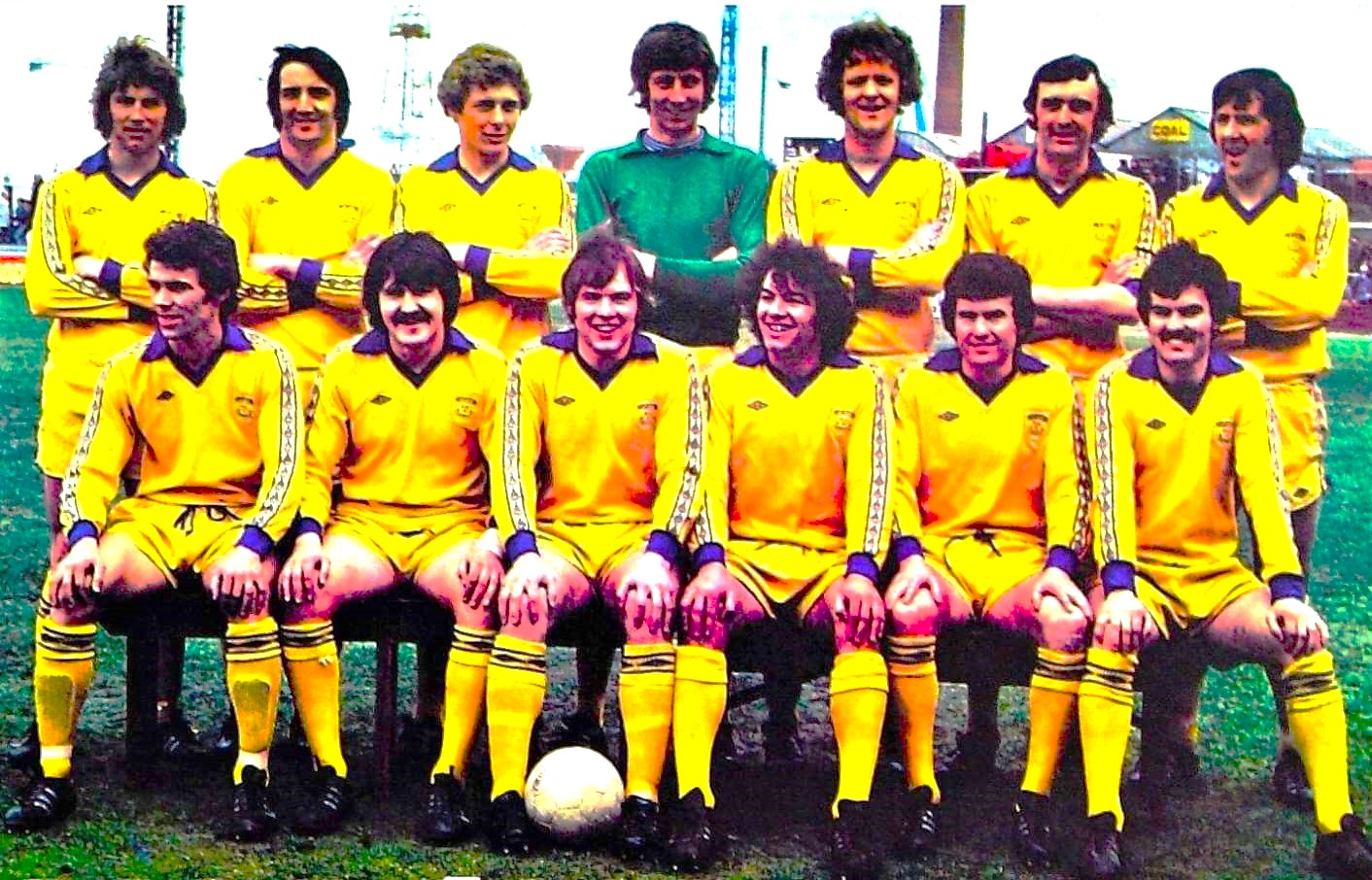
Champions in 1978
• 1978-83
Morton enjoy 5 years in the 10 team Premier Division, particularly the first two seasons when home crowds average around 8,000. In November 1979, Morton briefly top the Division and are still in 2nd place by mid-March 1980. Andy Ritchie (voted Scottish Player of the Year in 1979) scores over 25 goals in 4 consecutive seasons. But there are disappointing semi-final defeats in the League Cup in 1979, and the Scottish Cup in 1981. Gradually the team breaks up, with defender George Anderson, Jim Tolmie, Bobby Thomson and Neil Orr all leaving, Orr for a club record fee. Relegation follows in 1983, and with it, the departure of manager Rooney, and a host of other players, including keeper Roy Baines, centre back Joe McLaughlin, and Andy Ritchie, whose 127 League and Cup goals make him 3rd in the all-time scoring charts.
The 20th Century 1983-1999
• 1983-1988
The following years see the club promoted twice more as First Division Champions only to drop back down immediately from the Premier Division. There were well deserved promotions in 1984 and 1987, record breaking relegations in 1985 and 1988 with 100 League goals conceded in each. In 1983/84, a much-changed squad under manager Tommy McLean wins the title convincingly, with the goals coming from Dougie Robertson and John McNeil. Davie Hayes, by then the club record holder with 465 games leaves the club.. Tommy McLean moves on and his brother Willie oversees a dreadful season, with just 5 league wins, and a goal difference of minus 71. There is consolation in the selection of centre-back Jim Duffy as Scotland’s Player of the Year.
• Director and former manager Hal Stewart passes away on 2nd February 1984.
• Top goalscorer Allan McGraw returns to the club as manager in 1985, and the following season returns the club to the Premier League, clinching promotion as Champions on the final day at Airdrie. New signing Rowan Alexander contributes 26 goals. Again, the challenges of the Premier Division are too great. Only 3 League wins are secured in 44 games, with a goal difference of -73. Jim Holmes moves to Falkirk after 12 years and a record 532 appearances for the club.
• 1988-1994
These years are spent in the First Division; under Chairman John Wilson, and McGraw’s astute management, significant income accrues from the development and sale of players, whilst retaining second tier status, and dealing with the emerging ground safety requirements. Brian Reid, Allan Mahood, David Hopkin, Alex Mathie, Tommy Turner and the manager’s son Mark generate over £1.5m in fees, as the youth policy pays dividends. On the pitch, there is an appearance in the Challenge Cup Final in 1992, but defeat to Hamilton Accies.
• The club is formally renamed Greenock Morton Football Club in 1994.
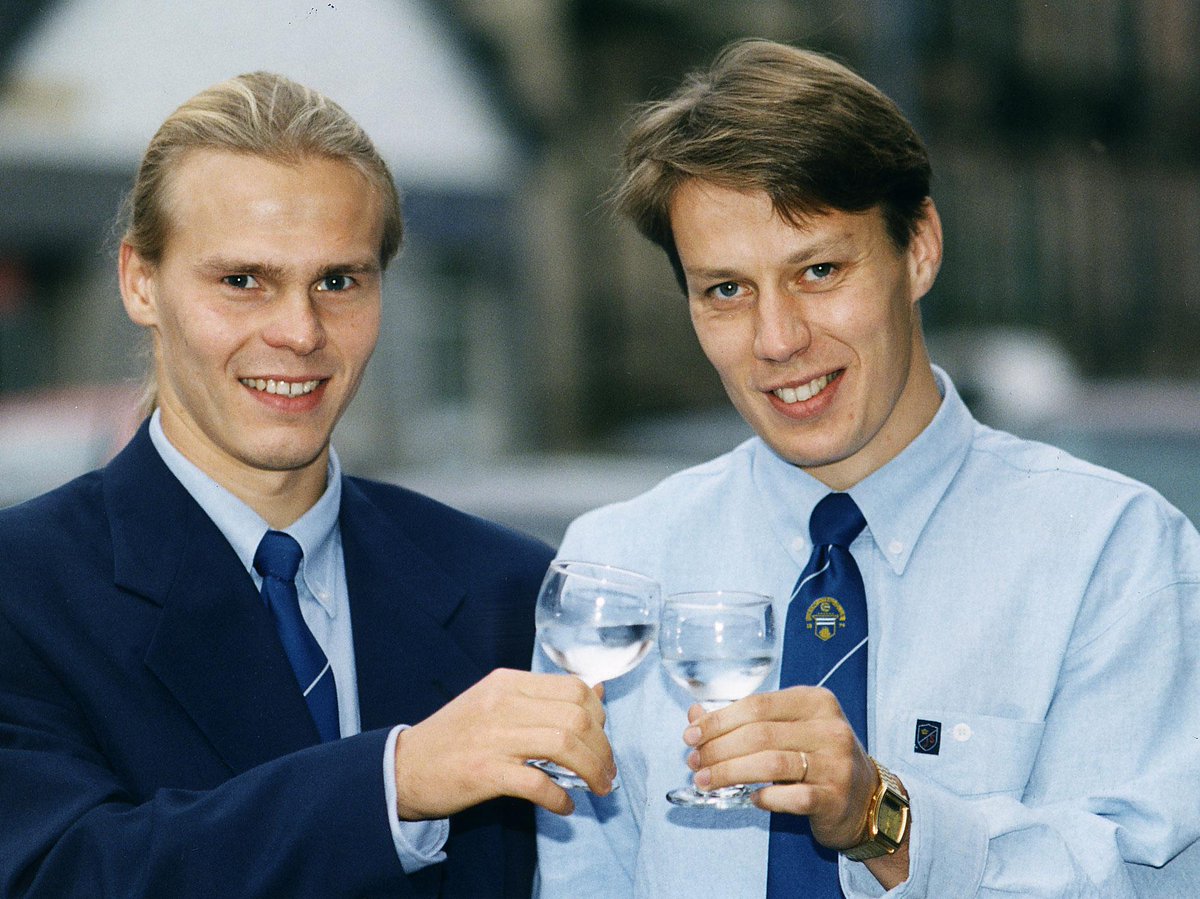
Marko Rajamaki and Janne Lindberg
• 1994-1997
League reorganisation in 1994, coupled with a spate of injuries, sees Morton fall to the new Division Two (or third tier) . Bolstered by the signing of Finnish internationals Janne Lindberg and Marco Rajamaki for a combined £250,000, the club bounces back, winning its 7th League title . Striker Rowan Alexander departs having scored 122 goals for Morton, tied with Jimmy Gourlay in 4th place in the scoring list. The following season Morton come close to another promotion after an exhilarating promotion challenge, as injuries, and the sale of midfielder Derek McInnes de-rail the campaign. By 1997 top striker Derek Lilley joins Leeds Utd for a club record £0.5m, and a change of ownership is in the air.
• 1997-2000
Hugh Scott acquires the majority shareholding in Morton in 1997, and quickly installs Billy Stark as Manager, Allan McGraw leaving the club. By 1998, keeper David Wylie (with a record 556 appearances) and right back Derek Collins have moved on, amidst a procession of comings and goings.
The 21st Century 2000-2024
• 2000-2003
The redevelopment of the Cowshed starts but doesn’t progress as matters deteriorate on and off the park. A deal to sell the club falls through and Morton is placed into Administration in December 2000, giving birth to the “Save The Ton” campaign, and eventually the purchase of newly relegated Morton, by Douglas Rae in August 2001. With no players, and a dilapidated stadium, it takes a massive effort and a great deal of investment to turn things round.
• Relegation to the bottom (fourth tier) in 2002 is the nadir, but with a redeveloped Cowshed, and a greatly improved playing staff, Morton win the Division Three Championship in May 2003, beating Peterhead 1-0 before a record Third Division crowd of 8,500. New striker Alex Williams scores 26 goals, and the Trophy is presented to skipper Derek Collins, who will reach a record 618 matches for Morton before moving on in 2005.
• 2004-2007
After 4 years of trying, and 4th, 3rd and 2nd placed finishes, promotion back to Tier 2 is achieved in 2007, in convincing style with a club record 77 points and a goal difference of +44. There’s an exciting 3-1 home cup win against Premier League Kilmarnock too.
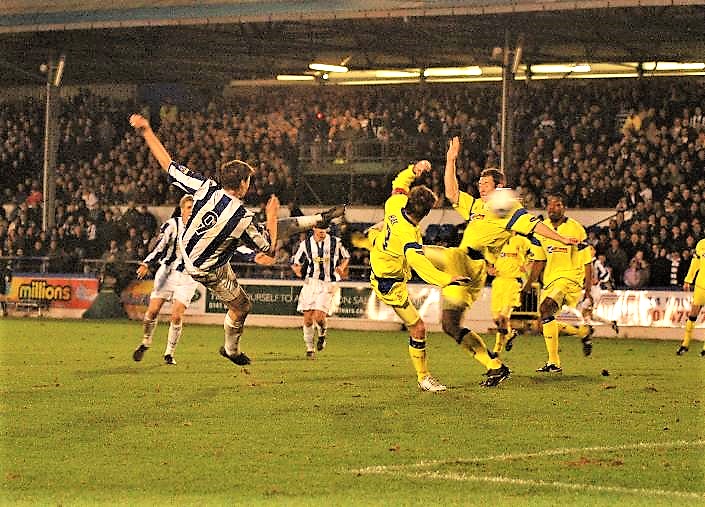
Chris Templeman Scores vs Kilmarnock
• 2007-2014
Morton continue as an established second tier club throughout this time, finishing second in 2013 in pre-play off times. Between 2004 and 2013, Peter Weatherson scores 122 goals for the club , to become equal 4th in the all-time scoring list. and top scorer in the 21st Century. The following season – 2013/14 – everything changes; having sensationally knocked Celtic out of the League Cup winning 1-0 at Parkhead in September 2013, League form is abysmal, and the club remain rooted to the bottom of the table for the remainder of the season culminating in relegation from the Championship to League One – with only 6 wins in 36 matches.
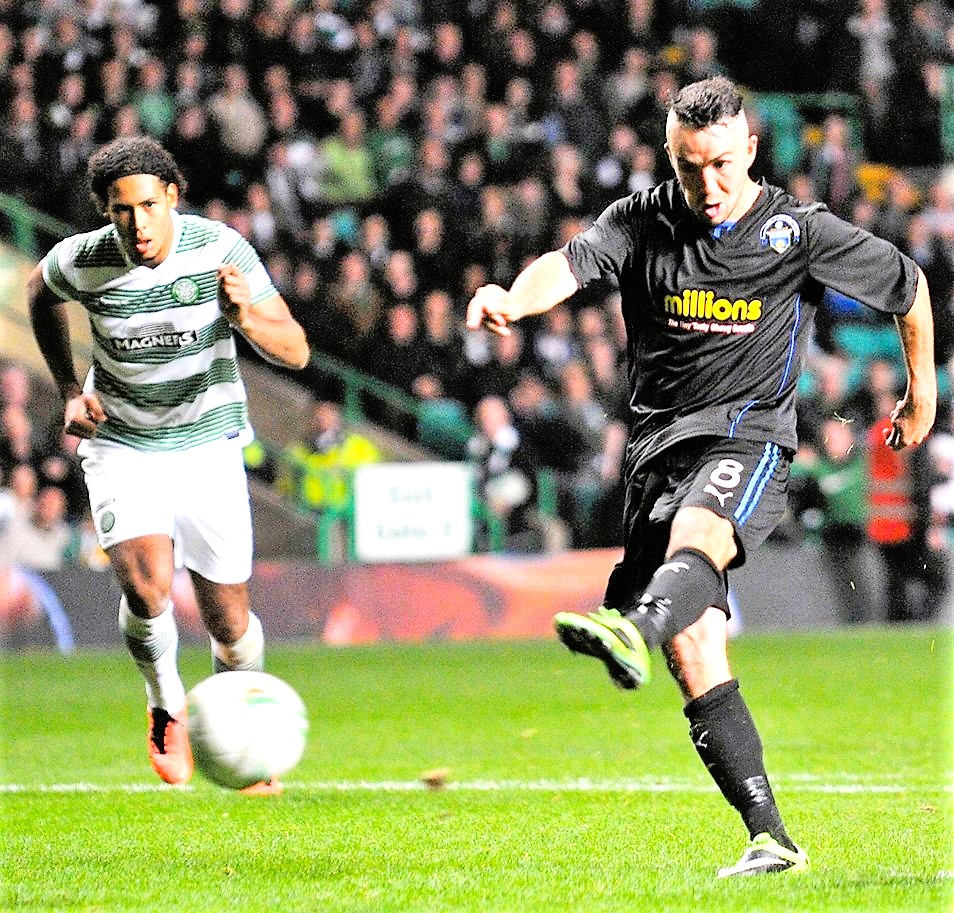
Dougie Imrie Scores vs Celtic
• 2015-2024
Promotion and Morton’s 10th Championship are achieved by new manager Jim Duffy, taking Morton back to the second-tier at the first time of asking; his side subsequently reaches the Championship play-offs and a League Cup semi-final v Aberdeen in 2016/17 season. The Championship remains a highly competitive league and over the past decade, Morton has faced current Premiership clubs Rangers, Hibernian, Hearts, Dundee, Dundee United, St Mirren and Kilmarnock on Championship business.
• 2022
Morton Club Together takes control of Greenock Morton FC. which becomes the latest Scottish club to be Community owned.
